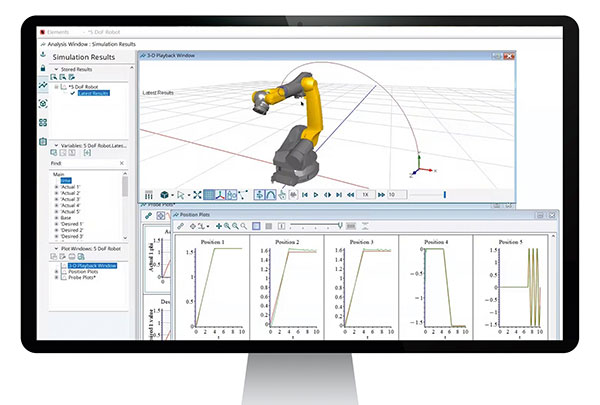Hexagon Debuts System-Level Modeling Solution
Using the software, teams can evaluate the performance and feasibility of new design concepts quickly to inform more efficient product development, company notes.

Elements’ system-level modelling can be used across a wide range of industries, from robotics to aerospace, and from automotive to energy generation. Image courtesy of Hexagon.
Latest News
December 5, 2022
Hexagon's Manufacturing Intelligence division has introduced Elements, new simulation software that helps engineering teams understand system behavior, given complexities of modern products, the company says. Using the software, teams can evaluate the performance and feasibility of new design concepts quickly to inform more efficient product development, according to the company.
Elements addresses integrated, multi-disciplinary system development and end-to-end workflows. Achieving this requires the integration of all relevant engineering disciplines, control systems and third-party supplier systems to understand how the domains interact, and how a design decision in one discipline impacts others.
Systems engineers can easily learn to use the Elements software, using its drag-and-drop environment to model any physics type or logic and analyse systems by intuitively connecting blocks—regardless of whether they represent electrical, hydraulic, mechanical components—to solve system-level engineering problems. It is based on the Modelica language, an open and widely used standard for building fast, flexible and customizable models.
Elements helps speed up engineering development because it ensures that system-level models compute quickly and efficiently by optimizing equations and code for fast calculation, but with no loss of fidelity, Hexagon reports.
As the design develops, and components and subsystems are detailed in specialist simulation software, the components can be routinely integrated into a larger system through full compliance with the FMI standard and Hexagon's SmartFMU technology. SmartFMU unlocks the functional mock-up unit (FMU) for supported Hexagon products so that changes can be made directly in the Elements system-level model without returning to the specialist computer-aided engineering (CAE) software and its user.
At launch, the software provides SmartFMU connectivity with Adams multibody dynamics software and Easy5. Future plans are likely to include workflows with Cradle CFD thermal-fluid dynamics and Actran acoustic simulation products, according to the company.
Standard FMI support and the novel SmartFMU plug-and-play capabilities, according to Hexagon, help address challenges of system complexity, including those for transportation electrification; for example:
- Helping automotive engineers to find optimal solutions to vehicle range optimization issues by considering a vehicle's energy use under different driving conditions, taking into account eDrive design, regenerative braking, climate control, ADAS safety requirements and battery choice.
- Improving the flexibility and accuracy of industrial robotics by designing control systems that take detailed mechanical system vibrations and interactions from multi-body dynamics simulation into account.
- Right-sizing heavy battery systems in new eVTOL aircraft designs by helping engineers understand the power draw during take-off and landing, safety margins and thermal management system controls.
- Implementing safer, more sustainable long-life battery systems by using Elements to design control systems that balance the improved performance of lithium-ion batteries at elevated temperatures with the impact heating has on cell degradation.
Elements was developed in close cooperation with Maplesoft, building upon its math engine to optimize system equations and deliver efficient simulation to Hexagon's customers.
“Elements offers engineers an easy way to explore behaviour of systems quickly and find better solutions to problems using simulation, before committing designs to subsequent resource-intensive engineering processes,” Mahesh Kailasam, general manager for Design and Engineering Software at Hexagon, comments. “We look forward to a long-term collaboration with Maplesoft, using its powerful and open technology foundations to realise synergies with our extensive Hexagon CAE ecosystem portfolio and deliver valuable capabilities to our customers.”
To learn more about Elements, visit hexagon.com/products/elements.
Sources: Press materials received from the company and additional information gleaned from the company’s website.
More Hexagon Coverage

More Hexagon Manufacturing Intelligence Coverage
Subscribe to our FREE magazine, FREE email newsletters or both!
Latest News
About the Author
DE’s editors contribute news and new product announcements to Digital Engineering.
Press releases may be sent to them via DE-Editors@digitaleng.news.







